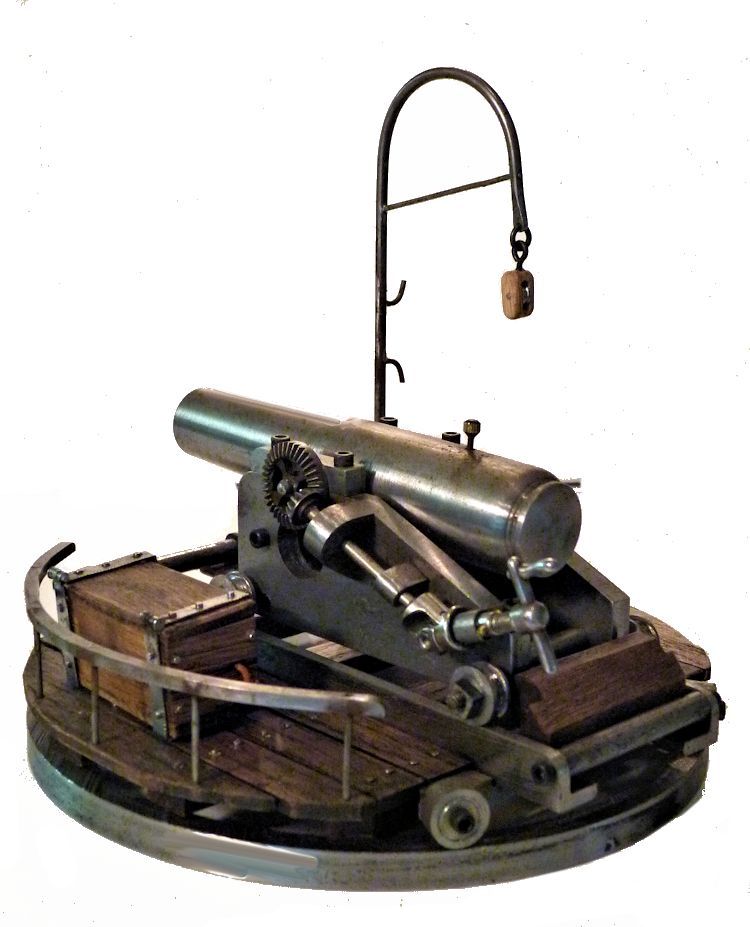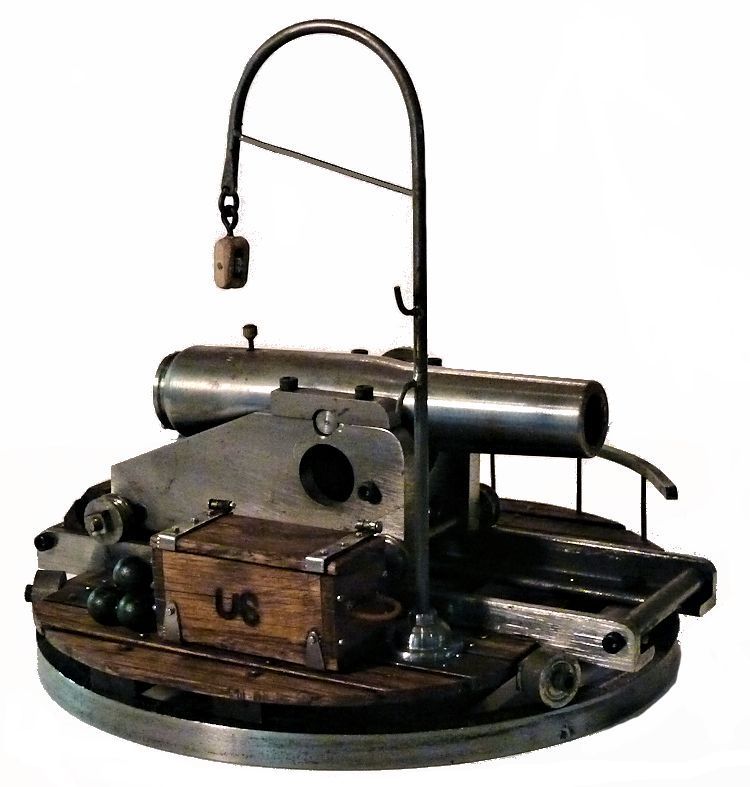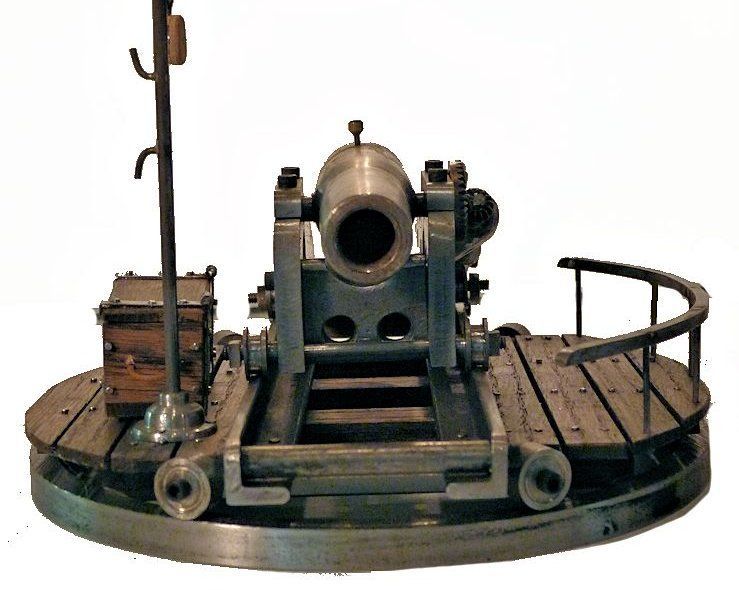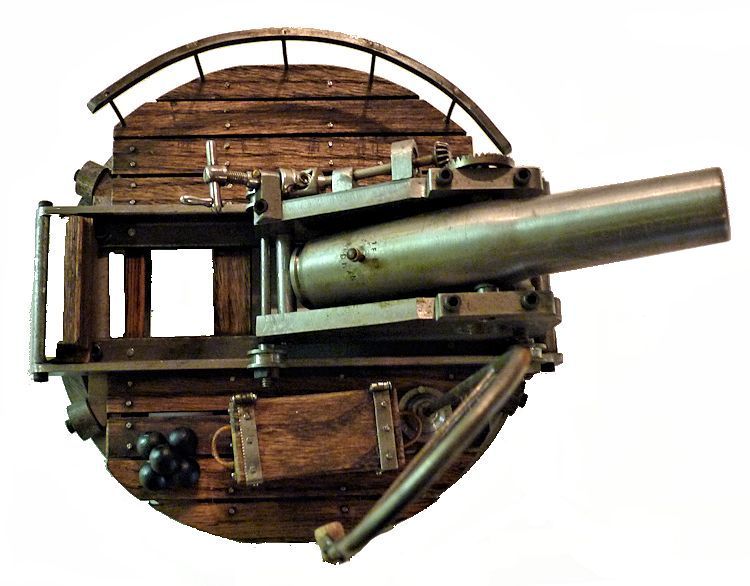CIVIL WAR RODMAN FLRTRESS CANNON DISPLAY

This high quality cannon assembly is mounted on a turnable deck which has a stack of cannon
balls and a wood ammunition case and hoist as accessories. The cannon realistically traverses and is shown above elevated
on its revolving steel and wood platform which for simplicity, we are calling a “turnstyle”.
Presented
is a Rodman Civil War Seige or Fortress cannon model with the trunnions in the centered position. It was made by a master
machinist from cold rolled steel with removable turnstyle including a stack of accessory cannon balls, a hoist with wood block,
and a wood ammunition trunk. The miniature hoist replicates how the real cannon balls were moved. The carriage rotates on
the turnstyle a full 360 degrees and the cannon elevates up and down using a scale hand crank. There is a wood ramrod to clean
the bore and to load a charge which is NOT recommended without first having a gunsmith test fire the cannon. The carriage
slides in an out on steel tracks with a wood bumper at the fired end moving from the load to fired position. The recently
made cannon display is said to be “one-of-a-kind”.
Completely
satisfied by young ordinance Officer, Thomas Jackson Rodman’s results, the War Department in 1860, authorized the casting
of a 15-inch smooth bore Columbiad. Even at that time a gun bigger than anything the world had ever seen. The first 15-inch
gun, “The Lincoln Gun”, made under Rodman’s personal supervision at the Fort Pitt Foundry, was sent to Fortress
Monroe, Va., where it was tested in March 1861 and became a model for the many Rodman guns which followed. This model replicates
the Columbiad cannon design. The picture below shows the display’s relative size compared to a large highball glass, 3
1/4″ D X 4″ T.

The picture below is
that of a typical Rodman Columbiad Civil War cannon installation and is of the 15-inch Rodman gun at Battery Rodgers, Alexandria, VA. The cannon’s barrel is slightly above the plane of the
horizon.

There
is a small touch hole with capped plunger above the rear chamber, but no attempt should be made to fire it without
a qualified gunsmith testing first.

This cannon is being offered for display only and should not be fired unless inspected by a gunsmith.

DIMENSIONS:
Display LOA 7 1/2″ Length
Barrel 4 3/4″ Bore .45″ or 45 Cal Touch hole 1/16″
Maximum Dia. of tube 1″ Dia. Tube at mouth
.77″ Max. Ring Dia. 7″
Weight of display 2 lbs. 13 oz. Diameter
of Lrg. wheels .41″

ACCESSORIES: Stack of 5 cannon balls. Wood plank turnstyle. Rectangular Ammunition
box with lid, 1 7/8″ x 1″ x 1″. Small wood rigging block
PROVENANCE: The cannon comes from the maker, a master machinist, acquired
in the normal course of business. It was said to be fired by him using a 35 gram Pyrodex P charge, but this should not be
considered a fool proof test. See CONDITION statement below. The workmanship is of very high quality. Barrel stamped “1861” over touch hole over “Rodman”.

CONDITION: Said to be recently made with all the metal parts of cold steel. The 1/16″ touch hole is at
the top of the breech and has a knurled knob. Said to have been fired using a black powder formula. For details see Provenance.
The gun carriage runs on tracks, in and out, from one side of the traversing ring, to the
other. WARNING: The carriage may fly off the track if fired as displayed.
This fine example
is being sold for display purposes only. No attempt should be made to fire it without inspection and instruction by a
gunsmith.
